#Webhook Security
Explore tagged Tumblr posts
Text
Shopify Webhooks Best Practices
Webhooks are a powerful tool in Shopify that allow developers to automate workflows, integrate third-party services, and keep external applications in sync with store data. By using Shopify webhooks, businesses can receive real-time updates on orders, customers, inventory, and more. However, improper implementation can lead to security risks, data inconsistencies, and performance issues. In this…
#API Call Optimization#E-commerce Automation#E-commerce Scalability#Real-Time Data Sync#Secure Webhook Implementation#Shopify API Integration#Shopify App Development#Shopify Development#Shopify Store Management#Shopify Webhooks#Shopify Workflow Automation#Webhook Performance Optimization#Webhook Security#Webhooks Best Practices
0 notes
Text
Integrating Payment Gateways in Django Applications
How to Integrate Payment Gateways in Django Applications
Introduction Integrating payment gateways is crucial for e-commerce applications and any service that requires online payments. Django provides a robust framework for integrating various payment gateways such as Stripe, PayPal, and more. This article will guide you through the process of integrating these payment gateways into your Django application, focusing on Stripe as an…
#Django payment integration#Django Stripe setup#online payments#Python web development#secure transactions#Stripe integration#webhooks
0 notes
Text
Januari update
Happy new years!
So this month I got a few more things working, though I did not really get everything done that I had planned for myself. Nonetheless a few things are worth mentioning, they are all related to the Discord bot so if you (used to) use that then you will like these updates!
My personal future got a lot more secure too, the job I have been working at offered me a permanent contract with a nice salary bump too. Stress levels have been low as a result! 💖
This post is a bit big, due to images and a lot of explaining text. To save reblogs from blasting people's dashboards there is a keep reading snip.
First of all, costs. This month the total cost was comparable to December, sitting at €8.51. As predicted, now that more stuff is being slowly re-added things like storage and database costs are going up. But really it is such an insignificant amount compared to the previous hosting solution this is essentially free.

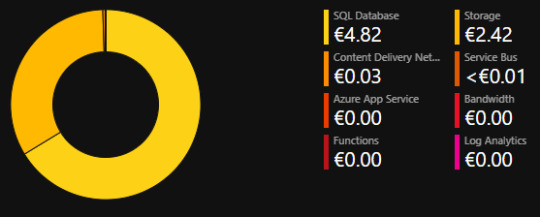
Discord
So what has changed to the discord bot? Well, a lot of things really. I got announcements to work! But it isn't as straightforward as before, but I did my best to keep it as simple as possible. The biggest thing is that I moved server location. It was in Australia before (don't ask, I was tired) and now it is in EU West. It being hosted in Australia significantly increased the response time of the bot, but it is all nice and fast now!
Discord Announcements
I can go into a lot of detail but the gist of it is that the bot in its current iteration is not actually a bot that can read and send messages in channels. While it has the [✓ BOT] icon next to the name it isn't actually 'there'. Everything is handled through HTTP requests, almost no different from you browsing the internet. As such I had to get a bit creative in how the bot sends messages without someone interacting with the bot, as such let me introduce you to: Webhooks!

You might have heard of, or used, webhooks with another bot before. Or some website offers webhook service that you can hook into Discord. This is really no different. You supply the bot with a webhook through an interaction and from then onward I use that webhook to post messages to.
Through the use of the /config command you can set up the webhooks on your server, assuming you have the Administrator permission on your server. Due to Discord's own limitations, the config navigation is not as clean as I would like it to be, but it works.
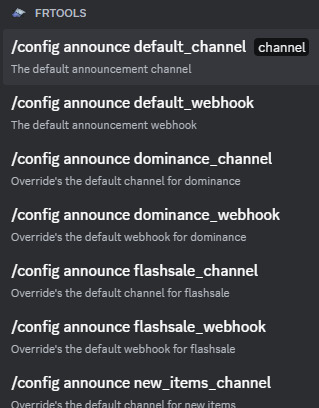
You might notice that New Items is back as well, yay! Still needs some work though, but in the simplest sense it works. Filters will come soon™️.
Now we just had the Crystalline Gala event and oh man, the New Items announcer got put through its paces. You see webhooks have a big advantage over normal messages being send by bots; they can hold up to 10 embeds each. So I took full advantage of that.
The video below shows just 5 messages, of varying amounts of embeds!
Lookup
I've added a new feature to the /lookup command too, allowing you to influence the result of the preview of the item (when applicable). For example, if you use the id lookup feature and the item is for a specific breed or gender (like a skin) then the supplied parameters don't do anything. Or when the gene is for an ancient breed it will only take into account your gender parameter.


That's all for this month, I got nothing too broad planned for Februari besides polishing the things above. I am missing stuff like custom emojis in the webhooks, the color of the embed is always black, etc. Small stuff really. I might work a little bit on getting the website part up again, but as it will be entirely different from before and thus a complete rewrite I will not throw out any promises. I have some ideas on how I want to do it but that way is essentially entirely new to me.
Speaking of, this entire project was originally started to advance my own knowledge and experience in things that I did not have much experience in as a professional programmer and thus far I am still learning new things almost every time I open up my editor. I am having a blast with this hobby project! (especially now that I no longer pay an arm and a leg for hosting)
Do you have any ideas on what you would like to see next? Something you feel should be changed? Just throw out random ideas? Reblog or post a reply, or send me an anonymous ask if you prefer!
#fr tools news#fr tools#frtools#fr#flight rising#flightrising#fr discord bot#discord bot#fr resources
6 notes
·
View notes
Text
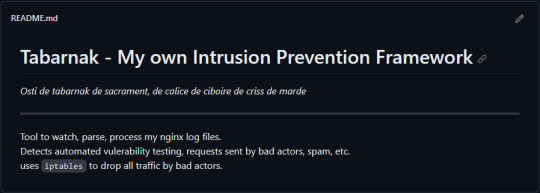
(this is a small story of how I came to write my own intrusion detection/prevention framework and why I'm really happy with that decision, don't mind me rambling)
Preface

About two weeks ago I was faced with a pretty annoying problem. Whilst I was going home by train I have noticed that my server at home had been running hot and slowed down a lot. This prompted me to check my nginx logs, the only service that is indirectly available to the public (more on that later), which made me realize that - due to poor access control - someone had been sending me hundreds of thousands of huge DNS requests to my server, most likely testing for vulnerabilities. I added an iptables rule to drop all traffic from the aforementioned source and redirected remaining traffic to a backup NextDNS instance that I set up previously with the same overrides and custom records that my DNS had to not get any downtime for the service but also allow my server to cool down. I stopped the DNS service on my server at home and then used the remaining train ride to think. How would I stop this from happening in the future? I pondered multiple possible solutions for this problem, whether to use fail2ban, whether to just add better access control, or to just stick with the NextDNS instance.
I ended up going with a completely different option: making a solution, that's perfectly fit for my server, myself.
My Server Structure
So, I should probably explain how I host and why only nginx is public despite me hosting a bunch of services under the hood.
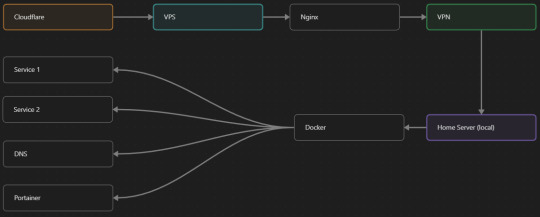
I have a public facing VPS that only allows traffic to nginx. That traffic then gets forwarded through a VPN connection to my home server so that I don't have to have any public facing ports on said home server. The VPS only really acts like the public interface for the home server with access control and logging sprinkled in throughout my configs to get more layers of security. Some Services can only be interacted with through the VPN or a local connection, such that not everything is actually forwarded - only what I need/want to be.
I actually do have fail2ban installed on both my VPS and home server, so why make another piece of software?
Tabarnak - Succeeding at Banning

I had a few requirements for what I wanted to do:
Only allow HTTP(S) traffic through Cloudflare
Only allow DNS traffic from given sources; (location filtering, explicit white-/blacklisting);
Webhook support for logging
Should be interactive (e.g. POST /api/ban/{IP})
Detect automated vulnerability scanning
Integration with the AbuseIPDB (for checking and reporting)
As I started working on this, I realized that this would soon become more complex than I had thought at first.
Webhooks for logging This was probably the easiest requirement to check off my list, I just wrote my own log() function that would call a webhook. Sadly, the rest wouldn't be as easy.
Allowing only Cloudflare traffic This was still doable, I only needed to add a filter in my nginx config for my domain to only allow Cloudflare IP ranges and disallow the rest. I ended up doing something slightly different. I added a new default nginx config that would just return a 404 on every route and log access to a different file so that I could detect connection attempts that would be made without Cloudflare and handle them in Tabarnak myself.
Integration with AbuseIPDB Also not yet the hard part, just call AbuseIPDB with the parsed IP and if the abuse confidence score is within a configured threshold, flag the IP, when that happens I receive a notification that asks me whether to whitelist or to ban the IP - I can also do nothing and let everything proceed as it normally would. If the IP gets flagged a configured amount of times, ban the IP unless it has been whitelisted by then.
Location filtering + Whitelist + Blacklist This is where it starts to get interesting. I had to know where the request comes from due to similarities of location of all the real people that would actually connect to the DNS. I didn't want to outright ban everyone else, as there could be valid requests from other sources. So for every new IP that triggers a callback (this would only be triggered after a certain amount of either flags or requests), I now need to get the location. I do this by just calling the ipinfo api and checking the supplied location. To not send too many requests I cache results (even though ipinfo should never be called twice for the same IP - same) and save results to a database. I made my own class that bases from collections.UserDict which when accessed tries to find the entry in memory, if it can't it searches through the DB and returns results. This works for setting, deleting, adding and checking for records. Flags, AbuseIPDB results, whitelist entries and blacklist entries also get stored in the DB to achieve persistent state even when I restart.
Detection of automated vulnerability scanning For this, I went through my old nginx logs, looking to find the least amount of paths I need to block to catch the biggest amount of automated vulnerability scan requests. So I did some data science magic and wrote a route blacklist. It doesn't just end there. Since I know the routes of valid requests that I would be receiving (which are all mentioned in my nginx configs), I could just parse that and match the requested route against that. To achieve this I wrote some really simple regular expressions to extract all location blocks from an nginx config alongside whether that location is absolute (preceded by an =) or relative. After I get the locations I can test the requested route against the valid routes and get back whether the request was made to a valid URL (I can't just look for 404 return codes here, because there are some pages that actually do return a 404 and can return a 404 on purpose). I also parse the request method from the logs and match the received method against the HTTP standard request methods (which are all methods that services on my server use). That way I can easily catch requests like:
XX.YYY.ZZZ.AA - - [25/Sep/2023:14:52:43 +0200] "145.ll|'|'|SGFjS2VkX0Q0OTkwNjI3|'|'|WIN-JNAPIER0859|'|'|JNapier|'|'|19-02-01|'|'||'|'|Win 7 Professional SP1 x64|'|'|No|'|'|0.7d|'|'|..|'|'|AA==|'|'|112.inf|'|'|SGFjS2VkDQoxOTIuMTY4LjkyLjIyMjo1NTUyDQpEZXNrdG9wDQpjbGllbnRhLmV4ZQ0KRmFsc2UNCkZhbHNlDQpUcnVlDQpGYWxzZQ==12.act|'|'|AA==" 400 150 "-" "-"
I probably over complicated this - by a lot - but I can't go back in time to change what I did.
Interactivity As I showed and mentioned earlier, I can manually white-/blacklist an IP. This forced me to add threads to my previously single-threaded program. Since I was too stubborn to use websockets (I have a distaste for websockets), I opted for probably the worst option I could've taken. It works like this: I have a main thread, which does all the log parsing, processing and handling and a side thread which watches a FIFO-file that is created on startup. I can append commands to the FIFO-file which are mapped to the functions they are supposed to call. When the FIFO reader detects a new line, it looks through the map, gets the function and executes it on the supplied IP. Doing all of this manually would be way too tedious, so I made an API endpoint on my home server that would append the commands to the file on the VPS. That also means, that I had to secure that API endpoint so that I couldn't just be spammed with random requests. Now that I could interact with Tabarnak through an API, I needed to make this user friendly - even I don't like to curl and sign my requests manually. So I integrated logging to my self-hosted instance of https://ntfy.sh and added action buttons that would send the request for me. All of this just because I refused to use sockets.
First successes and why I'm happy about this After not too long, the bans were starting to happen. The traffic to my server decreased and I can finally breathe again. I may have over complicated this, but I don't mind. This was a really fun experience to write something new and learn more about log parsing and processing. Tabarnak probably won't last forever and I could replace it with solutions that are way easier to deploy and way more general. But what matters is, that I liked doing it. It was a really fun project - which is why I'm writing this - and I'm glad that I ended up doing this. Of course I could have just used fail2ban but I never would've been able to write all of the extras that I ended up making (I don't want to take the explanation ad absurdum so just imagine that I added cool stuff) and I never would've learned what I actually did.
So whenever you are faced with a dumb problem and could write something yourself, I think you should at least try. This was a really fun experience and it might be for you as well.
Post Scriptum
First of all, apologies for the English - I'm not a native speaker so I'm sorry if some parts were incorrect or anything like that. Secondly, I'm sure that there are simpler ways to accomplish what I did here, however this was more about the experience of creating something myself rather than using some pre-made tool that does everything I want to (maybe even better?). Third, if you actually read until here, thanks for reading - hope it wasn't too boring - have a nice day :)
10 notes
·
View notes
Link
3 notes
·
View notes
Text
𝐅𝐢𝐧𝐠𝐞𝐫𝐬𝐩𝐨𝐭.𝐢𝐎 adalah solusi Sistem Yang Terintegrasi yang terbaik dengan fitur super lengkap demi sistem manajemen karyawan yang 𝐋𝐞𝐯𝐞𝐥 𝐔𝐩 Dilengkapi dengan teknologi 𝐬𝐜𝐚𝐧 𝐆𝐏𝐒 + 𝐅𝐚𝐜𝐞 𝐑𝐞𝐜𝐨𝐠𝐧𝐢𝐭𝐢𝐨𝐧, karyawan bisa absensi kapan saja & dimana saja 𝐅𝐢𝐧𝐠𝐞𝐫𝐬𝐩𝐨𝐭.𝐢𝐎 dapat dikoneksikan dengan mesin absensi sidik jari / kartu / wajah bahkan yang terbaru dengan Palm Vein yang lebih secure dan profesional. Anda juga bisa mengembangkan aplikasi bisnis dengan Developer.fingerspot.io. Proses pemrograman menggunakan API & Webhook. Yuk beralih ke 𝐅𝐢𝐧𝐠𝐞𝐫𝐬𝐩𝐨𝐭.𝐢𝐎

1 note
·
View note
Text
I feel like self hosted AIs are gonna be the next big thing. Not necessarily generative LLMs, but things like Alexa, except it's yours, it doesn't report to a corporate master, and it's secure because nobody built webhooks into it to let someone walk in the front door, which is going to be true of any cloud product because they all have to phone home.
We've all learned the cloud can't be trusted, not because there's something massively inherently insecure about Internet hosting, but because all companies with cloud services are bastards (and if they're not, just watch what happens when they get successful.) Who wants to trust big corporations anymore? Not me.
Anyway, there is software that lets you break DRM on DVDs enough that you can rip copies of media that is physical. If you buy your physical media you do not need to deal with the inconvenience of "I gotta have a DVD player hooked to my television or PC" as long as you have one DVD player hooked to a moderately powerful machine somewhere in your house that can do the rips.
Hey, look at me. Look at me. I’ve said it once and I’ll say it again: you need to condition yourself to being okay with being inconvenienced by things. The first time I spoke about this I meant it in a mental health way- it is good to go out to the store and see people versus just ordering alone at home- but there is another more pressing societal issue you should be more concerned about as well.
Any service you rely on for convenience can be weaponized against you the moment you begin to rely on it. Streaming used to be a cheap and convenient way to see movies at home. It is now exorbitantly expensive, you need multiple accounts just to get what you want, and any of those movies can be taken from you at any time. And unless you have gotten used to going through the “inconvenience” of owning physical media, you can do nothing about it. Same goes for buying things on Amazon. Same goes for any service like DoorDash etc. These companies WANT you to be reliant on them for convenience so they can do whatever they want to you because, well, what else are you gonna do?
Same thing goes for the uptick in AI. If you train yourself to become reliant on AI for doing basic things, you will be taken advantage of. It is only a matter of a couple years before there are no free AI services. Not only that, but in the usage of AI’s case, it is robbing you of valuable skills that you need to curate that you will be helpless without the moment the AI companies drive in the knife the way they have done with streaming. Delivery. Cable. Internet. Etc. It will happen to AI too. And if you are not practicing skills such as. Writing. You are not only going to be at the mercy of AI companies in the digital world, but you are going to be extremely easy to take advantage of in real life too.
I am begging you to let go of learned helplessness. I am begging you to stop letting these companies TEACH you helplessness. Do something like learn to pirate. It is way more inconvenient at the beginning, but once you know how, it is one less way companies can take advantage of you. Garden. Go to the thrift store (older clothes hold up better anyway). These things take more time and effort, yes, but using time and effort are muscles you need to stretch to keep yourself from being flattened under the weight of our capitalist hellscape.
Inconvenience yourself. Please. Start with only the ways you are able. Do a little bit at a time. But do something.
43K notes
·
View notes
Text
Real-Time API Monitoring: The Key to Building Reliable, High-Performing Web Applications

today’s fast-paced digital world, Application Programming Interfaces (APIs) are the backbone of every modern web or mobile application. Whether it’s a weather app fetching real-time data or an e-commerce site processing payments via Stripe, APIs power almost everything behind the scenes.
But what happens when an API silently fails? Your app becomes sluggish—or worse—completely unusable. That’s where real-time API monitoring comes in.
What Is API Monitoring? API monitoring refers to the process of automatically testing and tracking the availability, performance, and response of APIs over time. Think of it as a health check system that watches your APIs 24/7, ensuring they’re up, fast, and doing exactly what they’re supposed to do.
Real-time API monitoring takes it a step further—you’re alerted the moment something breaks.
Why API Monitoring Matters Your application may look fine on the surface, but behind every button click, data request, or user login, there's often one or more APIs at work. If any of them fail:
Users get error messages
Transactions fail to process
Performance slows down
Trust, traffic, and revenue are lost
Real-time monitoring ensures you catch these issues before your users do.
What Does Real-Time API Monitoring Track? Availability (Uptime): Is the API online and accessible?
Response Time: How long does it take to get a response?
Correctness: Are the responses accurate and as expected?
Rate Limiting: Are you close to hitting API usage limits?
Authentication Issues: Is your token or API key expired or invalid?
Use Case: WebStatus247 API Monitoring in Action Let’s say you’re using WebStatus247 to monitor your app’s integration with a payment gateway like Razorpay or Stripe.
Here’s what happens:
You set up real-time monitoring for the endpoint /api/payment/status.
Every few minutes, WebStatus247 sends a request to test the API.
If the status code isn’t 200 OK, or the response time spikes, you receive instant alerts via email or SMS.
You check the logs, identify the issue, and take corrective action—often before users even notice a problem.
Real-Time Alerts: Your First Line of Defense The core advantage of real-time monitoring is instant awareness. With platforms like WebStatus247, you can:
Set custom alert thresholds (e.g., response time over 800ms)
Receive notifications via email, Slack, SMS, or webhook
Access logs and trend data for root-cause analysis
No more guesswork. No more blind spots.
Benefits of Real-Time API Monitoring
Improved Reliability Downtime is expensive. Monitoring helps you stay ahead of outages, ensuring high availability for your services.
Faster Incident Response The faster you know about a problem, the faster you can fix it. Real-time alerts reduce mean time to resolution (MTTR) significantly.
Better User Experience Users do not tolerate broken features. Monitoring ensures that critical functionality—such as login, search, or checkout—remains operational.
Developer Efficiency Developers and DevOps teams can focus on building instead of reacting. With confidence in system health, teams can innovate more freely.
Real Metrics Drive Better Decisions API monitoring is more than just failure prevention. It helps teams:
Optimize performance by identifying slow endpoints
Detect traffic patterns and usage peaks
Justify infrastructure investments with performance data
Improve API documentation and reliability over time
Monitoring Helps Security, Too Real-time monitoring can alert you to signs of potential security issues, such as:
Unauthorized access attempts
Token expiration or failures
Unexpected status codes or response anomalies
In a world where data breaches are costly, proactive monitoring adds a layer of protection.
Synthetic Monitoring vs Real User Monitoring Real-time API monitoring is a form of synthetic monitoring—it simulates user behavior by sending requests to your APIs at regular intervals. This is proactive, meaning it catches problems before users encounter them.
In contrast, Real User Monitoring (RUM) collects data from actual user interactions. Both have value, but synthetic monitoring is essential for early detection.
Best Practices for Effective API Monitoring Monitor All Business-Critical Endpoints: Especially those that affect user sign-in, checkout, and real-time data delivery.
Set Thresholds Carefully: Avoid alert fatigue by defining meaningful conditions.
Automate Token Checks: Monitor for token expiry or authentication errors.
Use Multiple Locations: Test from different regions to catch geo-specific outages.
Review and Analyze Logs: Use dashboards to understand trends and identify root causes.
Global Monitoring = Global Reliability For applications with a global audience, testing from a single server is not sufficient. API responses can vary by location due to server load, latency, or network issues.
WebStatus247 allows you to simulate user requests from multiple global locations. This helps ensure consistent performance and availability across regions.
Conclusion: Visibility Builds Confidence APIs are mission-critical. They power everything from user authentication to content delivery. Yet, because they’re invisible to the end user, their failure can go unnoticed—until the damage is done.
Real-time API monitoring helps teams stay ahead. It empowers you to identify issues early, act quickly, and ensure your application remains fast, stable, and trustworthy.
For any serious development or DevOps team, this is no longer optional. It is essential.
Start Monitoring Today Ready to ensure your APIs are fast, reliable, and always online? Visit WebStatus247 and start monitoring in minutes. Gain full visibility, prevent costly downtime, and improve user satisfaction with every request.
0 notes
Text
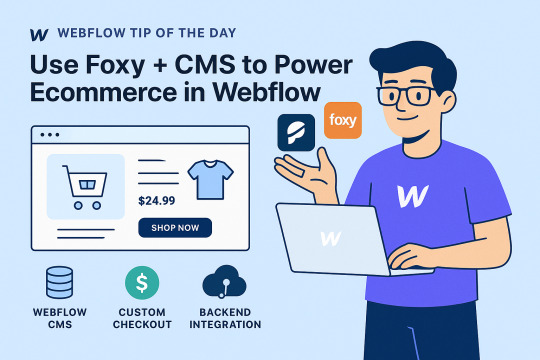
Webflow Tip of the Day
Use Foxy + CMS to Power E-commerce in Webflow Without Limiting Design
If you're building an ecommerce experience in Webflow but don’t want to be restricted by Webflow’s native ecommerce limitations, Foxy is the perfect integration to supercharge your setup using Webflow CMS!
Why Use Foxy for E-commerce in Webflow?
Webflow’s native ecommerce is powerful, but it lacks flexibility for custom checkout flows, subscriptions, digital downloads, complex pricing, or multi-currency.
Foxy lets you use Webflow CMS to manage your products visually and still enjoy powerful cart & checkout features.
How It Works:
Create a CMS Collection for your products (name, price, description, image, etc.)
Use a custom attribute to connect each product to Foxy, using:
data-fc-product="name:Product Name; price:24.99; code:SKU001;"
Embed a Foxy add-to-cart button inside each Collection Item using a <form> element or link block.
Customize the cart, checkout, and confirmation pages from Foxy’s backend.
Optional: Store customer data in platforms like Zapier, Airtable, or even Supabase for deeper backend integration.
Use Cases Perfect for Foxy:
Selling digital downloads (PDFs, courses, music)
Offering subscriptions or memberships
Donation forms
Product variants (sizes, colors, bundles)
Global shipping with dynamic rates
Pro Developer Tips:
Use Webflow CMS filters + Foxy logic to build dynamic product catalogs.
Combine with JavaScript to trigger dynamic pricing updates or variant displays.
Use Foxy webhooks or integrations to connect with external CRMs, email systems, or analytics platforms.
Result:
Fully custom design freedom with Webflow
Powerful and scalable e-commerce backend
Seamless checkout experience with secure payment gateways
🔗 Need inspiration or help with setup?
Check out my e-commerce builds:
🌐 Portfolio: webflowwork.com
🎯 Upwork: bit.ly/4iu6AKd
🎯 Fiverr: bit.ly/3EzQxNd
#webflow#freelancewebdeveloper#web design#webflowdesign#web development#webflowexperts#webflowlandingpage#website#nocode#ui ux design#fiverr gigs#fiverr#upwork#freelance#freelancing#webflowexpert#web developers#website development#foxy#cms development
0 notes
Text
🚀 How EasyLaunchpad Helps You Launch a SaaS App in Days, Not Months

Bringing a SaaS product to life is exciting — but let’s be honest, the setup phase is often a painful time sink. You start a new project with energy and vision, only to get bogged down in the same tasks: authentication, payments, email systems, dashboards, background jobs, and system logging.
Wouldn’t it be smarter to start with all of that already done?
That’s exactly what EasyLaunchpad offers.
Built on top of the powerful .NET Core 8.0 framework, EasyLaunchpad is a production-ready boilerplate designed to let developers and SaaS builders launch their apps in days, not months.
💡 The Problem: Rebuilding the Same Stuff Over and Over
Every developer has faced this dilemma:
Rebuilding user authentication and Google login
Designing and coding the admin panel from scratch
Setting up email systems and background jobs
Integrating Stripe or Paddle for payments
Creating a scalable architecture without cutting corners
Even before you get to your actual product logic, you’ve spent days or weeks rebuilding boilerplate components. That’s precious time you can’t get back — and it delays your path to market.
EasyLaunchpad solves this by providing a ready-to-launch foundation so you can focus on building what’s unique to your business.
🔧 Prebuilt Features That Save You Time
Here’s a breakdown of what’s already included and wired into the EasyLaunchpad boilerplate:
✅ Authentication (with Google OAuth & Captcha)
Secure login and registration flow out of the box, with:
Email-password authentication
Google OAuth login
CAPTCHA validation to protect against bots
No need to worry about setting up Identity or external login providers — this is all included.
✅ Admin Dashboard Built with Tailwind CSS + DaisyUI
A sleek, responsive admin panel you don’t have to design yourself. Built using Razor views with TailwindCSS and DaisyUI, it includes:
User management (CRUD, activation, password reset)
Role management
Email configuration
System settings
Packages & plan management
It’s clean, modern, and instantly usable.
✅ Email System with DotLiquid Templating
Forget about wiring up email services manually. EasyLaunchpad includes:
SMTP email dispatch
Prebuilt templates using DotLiquid (a Shopify-style syntax)
Customizable content for account activation, password reset, etc.
✅ Queued Emails & Background Jobs with Hangfire
Your app needs to work even when users aren’t watching. That’s why EasyLaunchpad comes with:
Hangfire integration for scheduled and background jobs
Retry logic for email dispatches
Job dashboard via admin or Hangfire’s built-in UI
Perfect for automated tasks, periodic jobs, or handling webhooks.
✅ Stripe & Paddle Payment Integration
Monetization-ready. Whether you’re selling licenses, subscription plans, or one-time services:
Stripe and Paddle payment modules are already integrated
Admin interface for managing packages
Ready-to-connect with your website or external payment flows
✅ Package Management via Admin Panel
Whether you offer basic, pro, or enterprise plans — EasyLaunchpad gives you:
CRUD interface to define your packages
Connect them with Stripe/Paddle
Offer them via your front-end site or API
No need to build a billing system from scratch.
✅ Serilog Logging for Debugging & Monitoring
Built-in structured logging with Serilog makes it easy to:
Track system events
Log user activity
Debug errors in production
Logs are clean, structured, and production-ready.
✅ Clean Modular Codebase & Plug-and-Play Modules
EasyLaunchpad uses:
Clean architecture (Controllers → Services → Repositories)
Autofac for dependency injection
Modular separation between Auth, Email, Payments, and Admin logic
You can plug in your business logic without breaking what’s already working.
🏗️ Built for Speed — But Also for Scale

EasyLaunchpad isn’t just about launching fast. It’s built on scalable tech, so you can grow with confidence.
✅ .NET Core 8.0
Blazing-fast, secure, and LTS-supported.
✅ Tailwind CSS + DaisyUI
Modern UI stack without bloat — fully customizable and responsive.
✅ Entity Framework Core
Use SQL Server or switch to your own DB provider. EF Core gives you flexibility and productivity.
✅ Environment-Based Configs
Configure settings via appsettings.json for development, staging, or production — all supported out of the box.
🧩 Who Is It For?
👨💻 Indie Hackers
Stop wasting time on boilerplate and get to your MVP faster.
🏢 Small Teams
Standardize your project structure and work collaboratively using a shared, modular codebase.
🚀 Startup Founders
Go to market faster with all essentials already covered — build only what makes your app different.
💼 What Can You Build With It?
EasyLaunchpad is perfect for:
SaaS products (subscription-based or usage-based)
Admin dashboards
AI-powered tools
Developer platforms
Internal portals
Paid tools and membership-based services
If it needs login, admin, payments, and email — it’s a fit.
🧠 Final Thoughts
Launching a SaaS product is hard enough. Don’t let the boilerplate slow you down.
With EasyLaunchpad, you skip the foundational headaches and get right to building what matters. Whether you’re a solo developer or a small team, you get a clean, powerful codebase that’s ready for production — in days, not months.
👉 Start building smarter. Visit easylaunchpad.com and get your boilerplate license today.
#.net #saasdevelopment #easylaunchpad #coding #easylaunch
0 notes
Text
🚀 How EasyLaunchpad Helps You Launch a SaaS App in Days, Not Months

Bringing a SaaS product to life is exciting — but let’s be honest, the setup phase is often a painful time sink. You start a new project with energy and vision, only to get bogged down in the same tasks: authentication, payments, email systems, dashboards, background jobs, and system logging.
Wouldn’t it be smarter to start with all of that already done?
That’s exactly what EasyLaunchpad offers.
Built on top of the powerful .NET Core 8.0 framework, EasyLaunchpad is a production-ready boilerplate designed to let developers and SaaS builders launch their apps in days, not months.
💡 The Problem: Rebuilding the Same Stuff Over and Over
Every developer has faced this dilemma:
Rebuilding user authentication and Google login
Designing and coding the admin panel from scratch
Setting up email systems and background jobs
Integrating Stripe or Paddle for payments
Creating a scalable architecture without cutting corners
Even before you get to your actual product logic, you’ve spent days or weeks rebuilding boilerplate components. That’s precious time you can’t get back — and it delays your path to market.
EasyLaunchpad solves this by providing a ready-to-launch foundation so you can focus on building what’s unique to your business.
🔧 Prebuilt Features That Save You Time
Here’s a breakdown of what’s already included and wired into the EasyLaunchpad boilerplate:
✅ Authentication (with Google OAuth & Captcha)
Secure login and registration flow out of the box, with:
Email-password authentication
Google OAuth login
CAPTCHA validation to protect against bots
No need to worry about setting up Identity or external login providers — this is all included.
✅ Admin Dashboard Built with Tailwind CSS + DaisyUI
A sleek, responsive admin panel you don’t have to design yourself. Built using Razor views with TailwindCSS and DaisyUI, it includes:
User management (CRUD, activation, password reset)
Role management
Email configuration
System settings
Packages & plan management
It’s clean, modern, and instantly usable.
✅ Email System with DotLiquid Templating
Forget about wiring up email services manually. EasyLaunchpad includes:
SMTP email dispatch
Prebuilt templates using DotLiquid (a Shopify-style syntax)
Customizable content for account activation, password reset, etc.
✅ Queued Emails & Background Jobs with Hangfire
Your app needs to work even when users aren’t watching. That’s why EasyLaunchpad comes with:
Hangfire integration for scheduled and background jobs
Retry logic for email dispatches
Job dashboard via admin or Hangfire’s built-in UI
Perfect for automated tasks, periodic jobs, or handling webhooks.
✅ Stripe & Paddle Payment Integration
Monetization-ready. Whether you’re selling licenses, subscription plans, or one-time services:
Stripe and Paddle payment modules are already integrated
Admin interface for managing packages
Ready-to-connect with your website or external payment flows
✅ Package Management via Admin Panel
Whether you offer basic, pro, or enterprise plans — EasyLaunchpad gives you:
#CRUD interface to define your packages
Connect them with #Stripe/#Paddle
Offer them via your front-end site or API
No need to build a billing system from scratch.
✅ Serilog Logging for Debugging & Monitoring
Built-in structured logging with Serilog makes it easy to:
Track system events
Log user activity
Debug errors in production
Logs are clean, structured, and production-ready.
✅ Clean Modular Codebase & Plug-and-Play Modules
EasyLaunchpad uses:
Clean architecture (Controllers → Services → Repositories)
Autofac for dependency injection
Modular separation between Auth, Email, Payments, and Admin logic
You can plug in your business logic without breaking what’s already working.
🏗️ Built for Speed — But Also for Scale
EasyLaunchpad isn’t just about launching fast. It’s built on scalable tech, so you can grow with confidence.
✅ .NET Core 8.0
Blazing-fast, secure, and LTS-supported.
✅ Tailwind CSS + DaisyUI
Modern UI stack without bloat — fully customizable and responsive.
✅ Entity Framework Core
Use SQL Server or switch to your own #DB provider. EF Core gives you flexibility and productivity.
✅ Environment-Based Configs
Configure settings via appsettings.json for development, staging, or production — all supported out of the box.
🧩 Who Is It For?
👨💻 Indie Hackers
Stop wasting time on boilerplate and get to your #MVP faster.
🏢 Small Teams
Standardize your project structure and work collaboratively using a shared, modular codebase.
🚀 Startup Founders
Go to market faster with all essentials already covered — build only what makes your app different.
💼 What Can You Build With It?
EasyLaunchpad is perfect for:
SaaS products (subscription-based or usage-based)
Admin dashboards
AI-powered tools
Developer platforms
Internal portals
Paid tools and membership-based services
If it needs login, admin, payments, and email — it’s a fit.
🧠 Final Thoughts
#Launching a #SaaS product is hard enough. Don’t let the boilerplate slow you down.
With EasyLaunchpad, you skip the foundational headaches and get right to building what matters. Whether you’re a solo developer or a small team, you get a clean, powerful codebase that’s ready for production — in days, not months.
👉 Start building smarter. Visit easylaunchpad.com and get your boilerplate license today.
#easylaunchpad #bolierplate #.net
1 note
·
View note
Text
Integrating Direct Mail API with Your CRM: A Step-by-Step Guide

In an era of omnichannel marketing, integrating direct mail with your CRM system allows your business to deliver personalized, tangible messages at scale. By connecting a Direct Mail API to your CRM, you can automate print campaigns just like emails—triggered, tracked, and customized. This step-by-step guide will walk you through the integration process, benefits, and best practices for using a Direct Mail API with CRMs like Salesforce, HubSpot, Zoho, and more.
Why Integrate Direct Mail with Your CRM?
Automation at Scale: Trigger direct mail campaigns based on customer behavior or data changes.
Improved Personalization: Use CRM data (name, address, preferences) to generate tailored mailers.
Increased Engagement: Physical mail cuts through digital clutter and boosts response rates.
Enhanced Campaign Tracking: APIs allow real-time tracking and analytics.
Sales Alignment: Automatically send follow-up letters or postcards based on pipeline stages.
Step-by-Step Integration Guide
Step 1: Choose the Right Direct Mail API
Before integration, evaluate key features:
API documentation quality
CRM compatibility
Webhook support
Print and mail services (postcards, letters, checks, etc.)
Real-time tracking
GDPR/CCPA compliance
Popular APIs:
Lob
PostGrid
Click2Mail
Postalytics
Sendoso (via Zapier)
Step 2: Map CRM Data Fields
Identify which CRM fields will be used for your direct mail campaigns:
Contact name and address
Segmentation tags
Trigger events (e.g., new signup, abandoned cart)
Custom attributes (e.g., subscription plan, purchase value)
Step 3: Connect CRM to the API
Use native integrations, middleware (like Zapier/Make), or custom scripts.
Examples:
Salesforce + Lob API: Use Apex code or a Zapier connection.
HubSpot + PostGrid: Integrate via webhook triggers.
Zoho CRM + Postalytics: Use Zoho Flow for automation.
Step 4: Design Your Direct Mail Template
Use HTML templates or drag-and-drop editors from the API provider. Leverage:
Merge tags (e.g., {{first_name}})
QR codes or personalized URLs (PURLs)
Brand-compliant visuals
Step 5: Test Your Workflow
Test with internal contact data
Review print previews
Check webhook responses
Track delivery and event logs via API dashboard
Step 6: Launch and Monitor Campaigns
Once tested:
Schedule or trigger live campaigns
Monitor open, delivery, and response metrics
Adjust templates based on performance
Best Practices for CRM + Direct Mail API Integration
Ensure Address Validation: Use an address verification API before sending.
Segmentation is Key: Create micro-targeted segments.
Compliance First: Use secure, compliant systems to handle personal data.
A/B Testing: Experiment with designs, messages, and offers.
Post-campaign Analysis: Sync back response data to your CRM.
Use Cases by CRM Type
Salesforce: Trigger renewal letters for subscription products.
HubSpot: Follow up with direct mail postcards after email bounces.
Zoho: Send loyalty mailers to high-LTV customers.
Pipedrive: Auto-send printed thank-you notes after deals close.
Conclusion
Integrating your CRM with a Direct Mail API enables a new level of offline automation that’s timely, relevant, and measurable. With the right setup, businesses can bridge the digital-physical gap and create memorable customer experiences at scale.
youtube
SITES WE SUPPORT
API To Automate Mails – Wix
0 notes
Text
Before You Buy: 9 Essential Checks for Resource Management Tools

Selecting a resource management platform is an investment in predictable profits and happier project teams. The right tool does far more than book names to tasks; it becomes the operational core of Professional Service Automation (PSA) software, aligning sales, delivery, and finance. Use these nine checks to separate robust solutions from glittering distractions.
1. Unified Portfolio Sightlines Demand a live dashboard that merges resource utilisation, demand curves, and project health into one view. Multi-level drill-downs—portfolio, programme, project, individual—let managers act before small capacity gaps snowball into missed milestones.
2. Skill-Based Allocation Engine Titles alone are blunt instruments. Look for granular skill matrices, certification tracking, and proficiency scoring. An allocation engine should auto-suggest best-fit talent, minimising bench time and raising delivery quality without manual detective work.
3. Forward-Looking Demand Forecasts Tomorrow’s workload is rarely the same as today’s. Prioritise software that models pipeline demand, runs “what-if” scenarios, and flags looming capacity shortfalls three to six months ahead—so hiring or subcontracting isn’t an emergency fire-drill.
4. Timesheet and Finance Symbiosis Timesheets are the raw material of accurate billing. Tight, native links between resource plans, time capture, and invoicing guard against revenue leakage, ensure cost codes are correct, and keep finance teams out of spreadsheet purgatory.
5. Multinational Complexity Handling If your delivery footprint spans countries, insist on native support for multiple currencies, tax regimes, holiday calendars, and entity-level profit-and-loss views. Dashboards should still consolidate seamlessly for executive reporting—no manual stitching required.
6. Self-Service Configurability Every organisation tweaks processes over time. Choose a platform with drag-and-drop layouts, rule-based workflow builders, and no-code custom fields. Operations teams can refine processes in hours—not wait weeks for vendor change requests.
7. Open, Standards-Based Integrations Resource management never lives in isolation. Verify REST or GraphQL APIs, pre-built connectors for CRM, HRIS, payroll, and finance tools, and event webhooks for real-time data exchange. Integration ease today prevents data silos tomorrow.
8. AI-Powered Predictive Insights Modern solutions embed machine learning to forecast over-allocation, recommend upskilling, and predict project overruns. Automation of low-risk approvals frees managers to coach teams and deepen client relationships—high-value work humans excel at.
9. Governance, Security, and Compliance Resource data includes salaries, utilisation rates, and client rates—prime targets for breaches. Confirm ISO 27001 or SOC 2 accreditation, region-specific data residency options, fine-grained role-based access, and audit logs that satisfy internal and client auditors alike.
Closing Thoughts
A comprehensive resource management tool is a catalyst for strategic decision-making—linking sales forecasts, delivery execution, and financial outcomes on a single platform. When each of these nine checks is satisfied, you gain real-time clarity, maximise utilisation, and build a culture where people feel valued and well-deployed. Evaluate methodically, involve stakeholders early, and you’ll acquire a system that scales with your growth ambitions—without compromising on agility, accuracy, or client satisfaction.
0 notes
Text
Stop Losing Leads: How ContactFormToAPI Ensures Instant API Sync
In today’s fast-paced digital world, every second counts—especially when it comes to capturing and managing leads. Businesses invest heavily in marketing campaigns to drive traffic to their websites, but often overlook a critical step in the sales funnel: ensuring form submissions are instantly routed to CRMs, APIs, and automation tools.
If you’re relying on manual methods, email notifications, or delayed workflows, you may already be losing valuable leads. That’s where ContactFormToAPI comes in—a powerful solution to instantly sync your contact form submissions with any REST API or CRM.
In this blog, we’ll explore the importance of instant lead capture, the dangers of lead loss, and how ContactFormToAPI can automate and secure your data flow.
The Hidden Problem: Delayed or Lost Leads
Imagine a potential customer filling out your website’s contact form. They’re interested, ready to buy or inquire, and waiting for a response. But if that form submission isn’t sent to your sales CRM—or worse, gets lost in email—you might never hear from them again.
Common causes of lead loss include:
Forms that only send email notifications
Delayed integrations with third-party tools
Inconsistent data syncing between platforms
Lack of API connectivity with your CRM or automation stack
Each of these issues creates a bottleneck in your lead generation funnel and ultimately costs you business.
Why Instant API Sync Matters
Speed is the key to conversion. According to research, contacting a lead within the first 5 minutes increases conversion chances by up to 9 times. But this only works if your form data reaches your tools instantly.
Instant API sync enables:
Real-time lead capture and nurturing
Immediate follow-ups via email or CRM triggers
Accurate data logging across your stack
Better automation and analytics
That’s why syncing your contact form data with your backend systems through APIs is essential for any modern business.
Meet ContactFormToAPI: Your Form Automation Ally
ContactFormToAPI is a no-code tool that bridges your website forms and any REST API. Whether you use WordPress (WPForms, Contact Form 7), Webflow, Wix, or a custom site, this tool enables you to send data to your CRM, Google Sheets, email marketing tools, or any REST API.🚀 Key Features:
Instant form-to-API sync
No code setup for most platforms
Support for GET, POST, PUT methods
Custom headers, tokens, and authentication
Zapier and Pabbly Webhook compatibility
Works with WPForms, Elementor, CF7, and more
With ContactFormToAPI, there’s no need to worry about missed leads or complex development work. You configure your endpoint, map your form fields, and the tool handles the rest—instantly.
Real-World Use Cases
Let’s break down how businesses across industries use ContactFormToAPI to streamline their operations:
1. Marketing Agencies
Connect contact forms to HubSpot, Mailchimp, or ActiveCampaign instantly to launch follow-up campaigns.
2. E-commerce Stores
Send contact or inquiry form data directly to fulfillment or order management APIs.
3. Healthcare Clinics
Automatically sync appointment request forms to EHR systems via secure API calls.
4. B2B Service Providers
Push lead data into Salesforce or Zoho CRM for real-time lead assignment and nurturing.
5. Educational Institutions
Route student inquiries to Google Sheets, CRM, or email workflows without delay.
How It Works
Step 1: Choose Your Form
Whether it’s WPForms, Contact Form 7, Elementor, or any HTML form, you can use ContactFormToAPI with ease.
Step 2: Configure API Endpoint
Add your destination API endpoint URL, method (POST/GET), and required headers or tokens.
Step 3: Map Your Fields
Use the form field names and map them to your API’s field structure. You can also add static data or use smart tags.
Step 4: Test and Go Live
Use the built-in testing tool to validate the integration. Once confirmed, every form submission will be sent to your API instantly.
Security and Reliability You Can Trust
ContactFormToAPI ensures data is transmitted securely using HTTPS, with support for authentication headers, bearer tokens, and custom headers. You can also:
View logs of API calls
Retry failed requests
Get email notifications on integration errors
This reliability helps ensure that no lead is lost due to technical glitches.
⏱ Save Time and Cut Manual Effort
If your current workflow involves manually exporting form data or checking inboxes, ContactFormToAPI can save you hours every week. With automation in place:
Sales teams can respond faster
Marketers can trigger nurturing emails automatically
Business owners can track performance with confidence
Integrates With Everything
The tool is designed to be platform-agnostic, meaning it works with:
Any REST API (Zapier, Pabbly, Integromat, etc.)
Any CMS (WordPress, Webflow, Wix, Squarespace)
Any CRM (HubSpot, Salesforce, Zoho, etc.)
Google Sheets, Airtable, Notion, or email tools
This flexibility makes ContactFormToAPI ideal for startups, agencies, and enterprise teams alike.
Bonus: Tips for Better Lead Capture
Even with instant API sync, it’s important to ensure your lead capture strategy is optimized. Here are a few tips:
Keep your form simple (3–5 fields max)
Use smart field validation
Add form analytics to track conversion rates
Offer an instant confirmation message or email
Regularly test your form-to-API setup
Final Thoughts: Stop the Leak, Start Growing
Lead generation isn’t just about getting people to your website—it’s about capturing them efficiently and following up without delay. If you’re still relying on email notifications or manual processing, you’re likely leaving money on the table.
ContactFormToAPI offers a fast, reliable, and code-free way to ensure your contact forms talk directly to your tools, whether it’s a CRM, Google Sheet, or custom backend API.
Ready to Stop Losing Leads?
Visit ContactFormToAPI.com to set up your form integration in minutes. Try the free version or explore premium features for more complex workflows.
0 notes
Text
Key Features to Look for in Direct Mail Automation Software for 2025
In an era of increasing digital noise, direct mail automation software stands as a powerful tool for businesses aiming to deliver personalized, tangible marketing experiences. As we step into 2025, choosing the right software means evaluating features that align with modern marketing needs—API integration, personalization, multichannel support, and analytics. This guide breaks down the most crucial features to consider when selecting direct mail automation tools for maximum ROI and customer engagement.

1. Seamless CRM Integration
One of the most vital features to consider is CRM integration. Whether you're using Salesforce, HubSpot, Zoho, or a custom solution, your direct mail software should easily sync with your CRM platform. This integration enables:
Automated trigger-based mail campaigns
Access to customer behavior and segmentation
Real-time updates on campaign performance
Why it matters in 2025: Personalized marketing driven by real-time customer data enhances engagement rates and streamlines campaign delivery.
2. API Access for Custom Workflows
A robust Direct Mail API allows developers and marketers to build custom workflows, trigger print-mail jobs based on events, and integrate with internal systems. Look for:
RESTful API with extensive documentation
Webhook support for real-time updates
Batch processing capabilities
SDKs in popular languages (Python, JavaScript, Ruby)
Benefits: APIs enable full automation and scalability, making it ideal for enterprise-level or high-volume businesses.
3. Variable Data Printing (VDP) Support
VDP lets you personalize every piece of mail—from names and offers to images and QR codes. The best software platforms will include:
Easy-to-use VDP templates
Integration with dynamic content from your CRM
Automated personalization for large campaigns
2025 Trend: Consumers expect personalized experiences; generic mailers are far less effective.
4. Omnichannel Campaign Support
Today’s marketing isn't just physical or digital—it’s both. Look for software that integrates with:
Email
SMS
Social retargeting
Retention platforms
Bonus: Omnichannel sequencing allows you to create smart workflows like sending a postcard if a user doesn’t open your email within 3 days.
5. Campaign Performance Analytics
Your software should offer deep insights into campaign results. Key metrics to look for include:
Delivery status
Response and conversion rates
Print volume tracking
QR code scans and redemption data
Advanced analytics in 2025 should include AI-driven performance predictions and suggestions for campaign improvements.
6. Address Verification & Data Hygiene Tools
Bad addresses cost money. Your software should offer built-in address verification, using tools like:
CASS Certification
NCOA (National Change of Address) updates
International address formatting
Postal barcode generation
2025 Consideration: With global shipping more common, international address validation is a must-have.
7. Pre-Built Templates and Design Tools
Not every marketer is a designer. High-quality platforms provide:
Drag-and-drop editors
Pre-designed templates for postcards, letters, flyers, catalogs
Brand asset management tools
These reduce campaign creation time and ensure brand consistency across every print asset.
8. Automation Triggers and Rules
Software should support rule-based automations, such as:
“Send a thank-you postcard 7 days after purchase”
“Trigger a re-engagement letter if a customer hasn’t interacted in 60 days”
“Send a discount coupon after a cart abandonment”
Smart triggers improve relevance and timing, critical for campaign success.
9. Cost Estimator and Budget Control
In 2025, transparency is key. The best platforms provide real-time:
Printing and postage cost estimations
Budget tracking dashboards
ROI calculators
Spend caps and approval flows
Marketing teams can stay within budget while ensuring campaign effectiveness.
10. Security and Compliance Features
Data privacy is non-negotiable. Your software should support:
GDPR, HIPAA, and CCPA compliance
Data encryption at rest and in transit
Role-based access control
Audit trails and logs
2025 Focus: With AI data processing and automation increasing, choosing a secure platform is mission-critical.
11. Print & Mail Network Integration
Top-tier software connects with certified printers and mail houses globally, allowing for:
Localized printing to reduce shipping time/costs
International delivery tracking
SLA-based delivery guarantees
Distributed networks enhance scalability and ensure timely delivery.
12. Scalability for Enterprise Growth
As your marketing grows, your platform should grow with you. Key considerations:
Support for millions of monthly mail pieces
User management for teams
Advanced scheduling
SLAs for uptime and performance
Conclusion
Direct mail is no longer old-fashioned—it’s a data-driven, automated marketing channel. When choosing direct mail automation software in 2025, prioritize platforms that offer integration, personalization, scalability, security, and advanced analytics. Investing in the right tool ensures your campaigns are cost-effective, personalized, and impactful across every customer touchpoint.
youtube
SITES WE SUPPORT
Automated Mailing API – Wix
1 note
·
View note
Text
The Power of Custom API Development: Seamless Integration for Scalable Growth
In the evolving world of digital transformation, businesses are no longer functioning within isolated systems. Whether it's a CRM talking to your website or an e-commerce platform syncing with a third-party logistics provider, interconnectivity is essential. This is where Custom API Development comes into play — a critical component in building agile, scalable, and intelligent digital infrastructures.
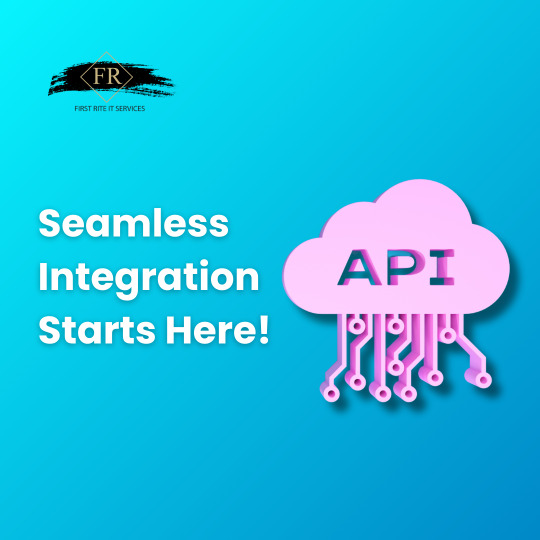
At First Rite IT Services, we specialize in delivering robust, secure, and purpose-driven APIs tailored to meet unique business needs across industries.
What is a Custom API, and Why Does It Matter?
An API (Application Programming Interface) acts as a bridge between software systems, allowing them to communicate, share data, and perform functions without human intervention. While third-party APIs offer standardized solutions, custom APIs are designed specifically around your business operations, ensuring optimal efficiency, security, and performance.
From internal tools to mobile apps and third-party platforms, custom APIs allow you to build seamless digital experiences — both for your users and your team.
Key Benefits of Custom API Development
1. Tailored Functionality
Every business has its own processes. Off-the-shelf APIs may not address your specific workflows. Custom APIs, on the other hand, are built to align perfectly with your internal systems and objectives.
2. Improved System Integration
Integrate your ERP, CRM, CMS, payment gateways, or legacy software into one unified system. With a well-crafted API, you eliminate silos and create an automated, synchronized tech ecosystem.
3. Enhanced Security
With growing cybersecurity concerns, data protection is non-negotiable. Custom APIs enable role-based access controls, encrypted communication, and secure authentication, reducing exposure to third-party vulnerabilities.
4. Scalability and Flexibility
As your business evolves, your systems should adapt. Custom APIs can be designed with future-proofing in mind, allowing for easy updates, feature expansion, and new service integrations.
5. Improved User Experience
When systems work seamlessly in the background, users enjoy a smoother, more intuitive interface — whether on a website, app, or platform.
First Rite IT Services: Your Trusted API Development Partner
We’ve helped startups, SMEs, and enterprises across sectors integrate and streamline their operations through custom-built APIs. Our process is collaborative and transparent — from initial discovery through to deployment and long-term support.
Our Custom API Services Include:
RESTful & SOAP API Development
Third-Party API Integration
Mobile & Web App API Services
API Testing, Monitoring & Documentation
Secure Cloud-Based API Architecture
Real-Time Data Exchange & Webhooks
Industries We Support
Our APIs have empowered clients in industries such as:
E-commerce & Retail
Healthcare & Telemedicine
Logistics & Transportation
Finance & Fintech
Real Estate & Construction
Education & eLearning
Let’s Build the Right Connection
Whether you're looking to connect internal tools or launch a new customer-facing product, our team at First Rite IT Services is ready to bring your systems together with speed, security, and precision.
Get in touch today to discover how a custom API can transform your digital operations.
0 notes